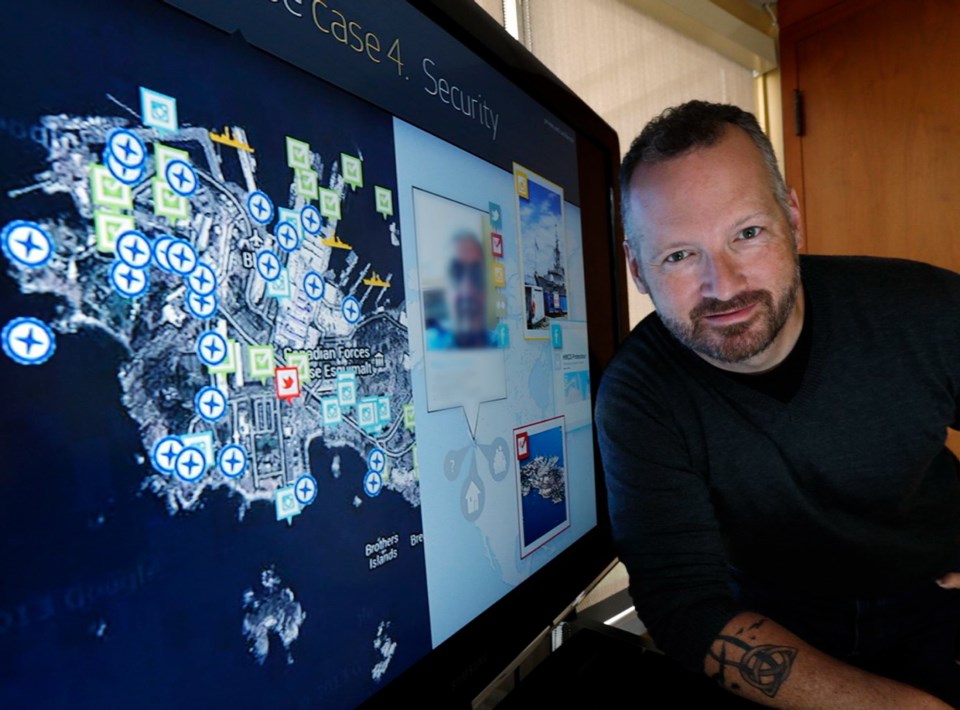With just a few keystrokes, anyone can peer behind the bars and fences of American detainment camps at Guantanamo Bay. A few more taps on the keyboard and there are images from military bases in Afghanistan and from some of the Canadian military’s more sensitive areas.
These are the kinds of images the public doesn’t usually get to see.
But a Victoria company breaking into the defence and security business has created a new application that’s made it possible to view images from behind some of the most secure locations in the world by aggregating social media feeds based on geo-mapping technology.
It’s a new perspective for most people and, in pulling together this kind of information, Echosec has pointed out a growing problem faced by defence departments and countries with the explosion of the use of social media.
Although Echosec — a company spun out of software developer Cloverpoint six weeks ago — has been around less than two months, it is already hearing from security organizations around the world interested in the technology and the solution to a growing problem.
“Word is getting out,” said CEO Karl Swannie, who spent part of Tuesday speaking to the head of one country’s counter-terrorism department and the head of another nation’s gang task force.
What groups like those are having trouble getting their heads around is the sheer volume of images and information popping up online through social media feeds — images, status updates and tweets — that offer a glimpse into what’s happening in so-called secure locations.
Swannie said while many naval bases, combat command centres and detainment camps require employees and those on their premises to sign non-disclosure or confidentiality agreements, it doesn’t appear to have stopped many people from posting about the sites, what goes on there and often from there.
Echosec’s chief technology officer, James Fernandes, said the U.S, military has been trying to crack down on the use of social media for years, though it appears to have had little effect.
During a demonstration, Swannie scrolls through images from the front lines of Afghanistan, behind the prison walls in Guantanamo and work being done on submarines at CFB Esquimalt.
“When you show people stuff like this, it’s like showing a gas leak ... they have a duty to clean it up,” he said. “It’s something they want to clean up. They just weren’t aware that it was there.”
Echosec is making its technology public as it begins raising capital for the next phase of its development.
Swannie said they have held back as they felt there was a duty to let organizations like the Canadian military know it had a problem before the company started selling its technology internationally.
Echosec is a fairly simple concept. On a digital map, the user draws a boundary and the technology will start aggregating social media feeds from within that zone. A page below the map, which is dotted by social media icons, will start listing the social media posts.
The demonstration site that is now live and public (demo.echosec.net) pulls from five social media feeds (Twitter, Flickr, Instagram, Picasa and Foursquare) and is based on what’s been posted up to that moment.
The version being developed for the defence and security industries and corporations can be set up for up to 480 media feeds and will continually update.
“It’s important to note all of this stuff is public. This is all available information — this is the stuff people post every day,” said Swannie. “We haven’t broken their non-disclosure agreements. They have. We have just happened to aggregate it all in one spot.”
Defence and security applications for the technology may be obvious, and it doesn’t take much imagination to consider what a hostile nation could do with the kinds of sensitive material made available.
But there are also commercial applications for Echosec. Companies can monitor productivity and safety to ensure employees are not posting images and information that could be detrimental. The tool can also be used for direct marketing as companies can use it to draw a boundary map in a certain area and send offers to all those who have checked in or engaged in social media within that zone.
In a business case put together for Fort McMurray, Alta., Echosec found images of people sleeping on the job, hiding, pictures from within security offices, employees being photographed apparently using drugs and images of equipment crashing. “There’s just a lot of stuff [a company] wouldn’t want to share,” said Swannie.
He said Echosec will offer a server for large corporations and defence departments and they can monitor the social media feeds.
“Then whenever people post something that breaks a non-disclosure agreement or confidentiality agreement they can act,” he said. That could mean termination, or simply having that employee take down the image or information posted. “You can’t stop people from doing things, but we can enforce their agreements. We can stop it, clean it and sanitize it.”
There is also an application for law enforcement, said Fernandes. “Police get a 911 call [and] they can quickly draw a geo-fence around that area,” he said, noting that could give them images from the scene and potential witnesses.
It also works for the individual who may be looking for a great spot to eat, good shopping or a venue for a night out in a specific area. Find an area and check the social media feeds for tips.



